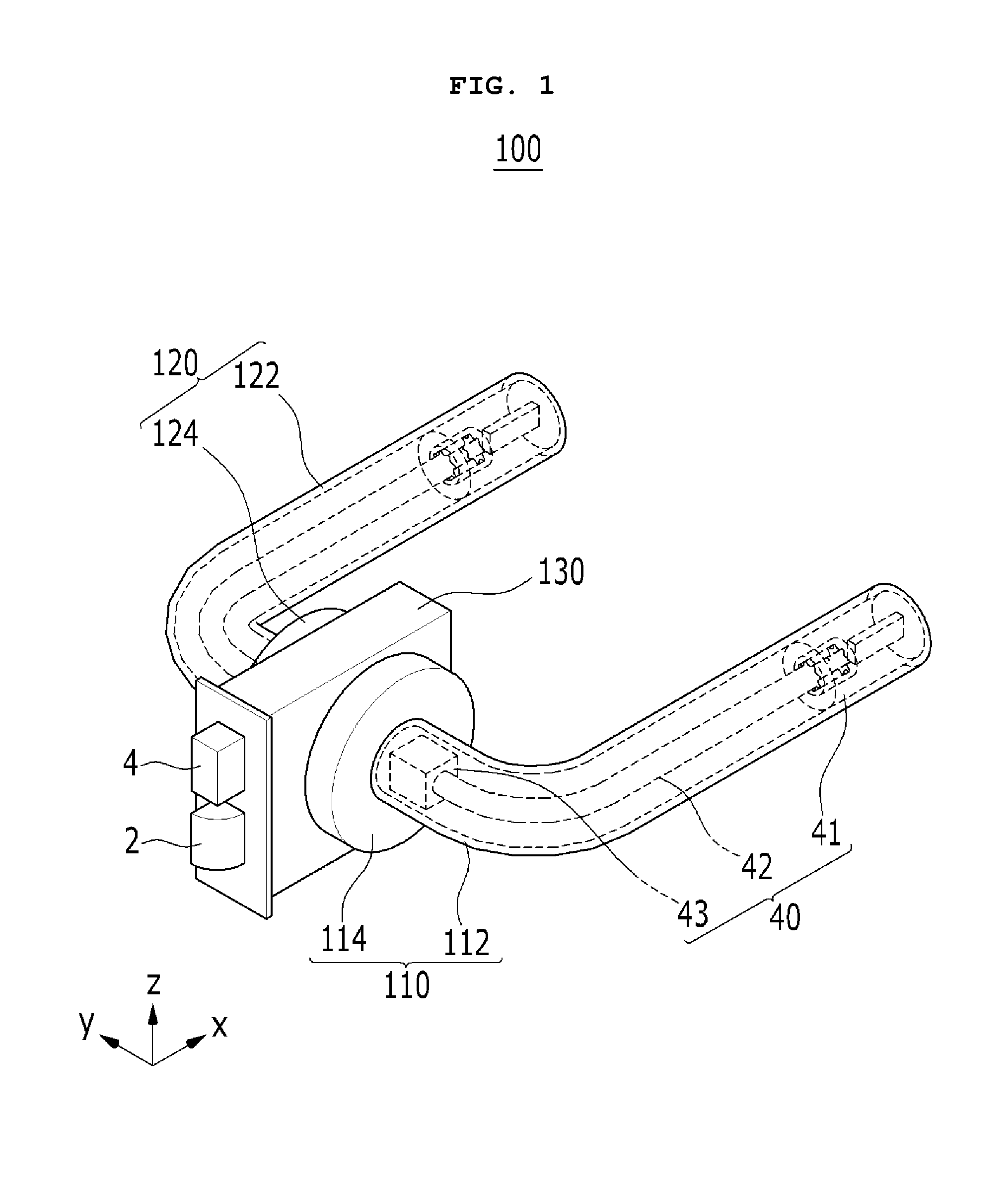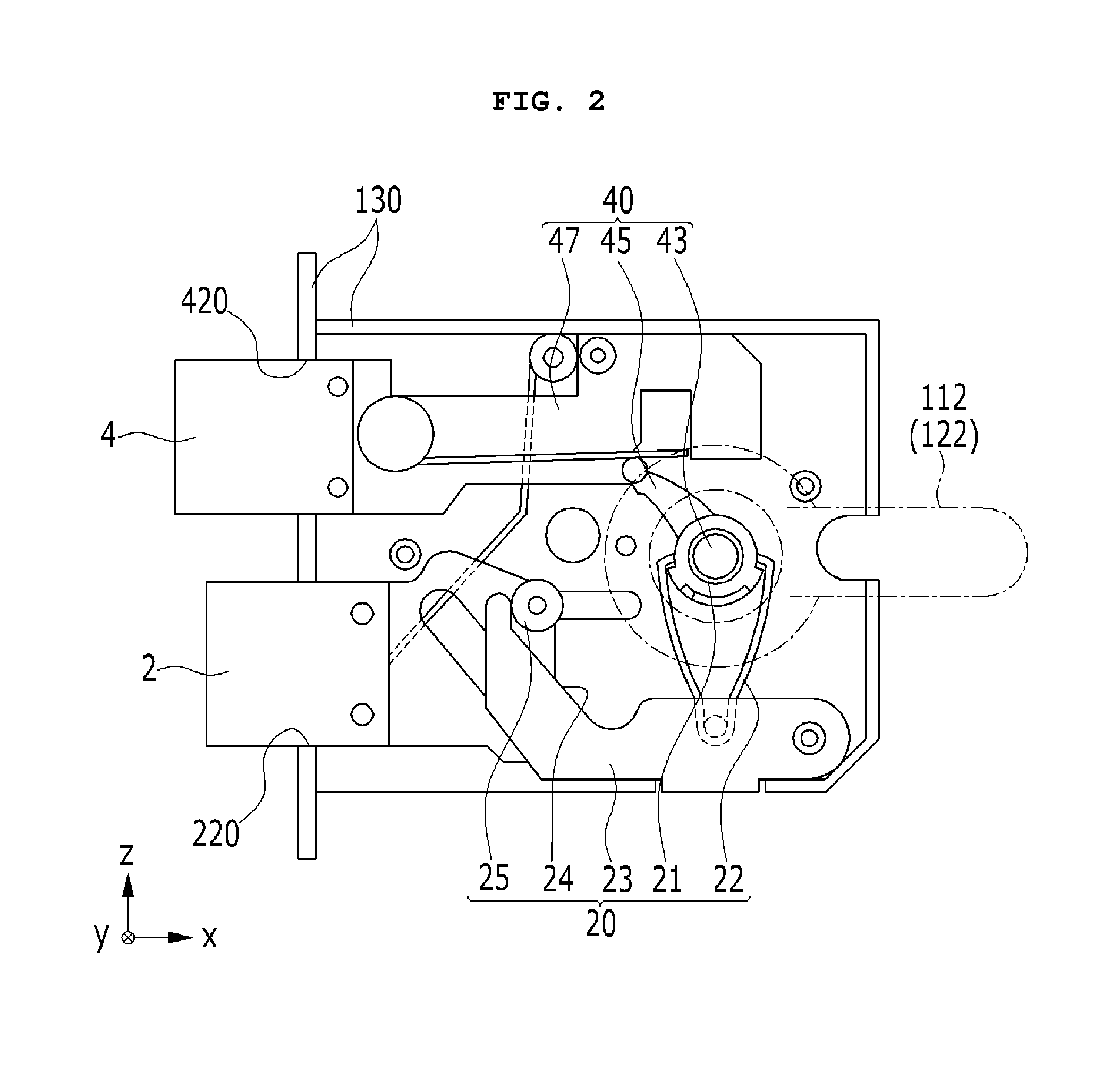Lever type handle and lock assembly for the same
a technology of lever type handle and lock assembly, which is applied in the direction of wing knobs, mechanical control devices, keyhole guards, etc., can solve the problems of inconvenient change of structure with the key to the structure, inability to have uniform appearance of handles, and poor etc., to achieve simplified lock assembly structure, easy operation by users, and excellent appearance of lever type handles
- Summary
- Abstract
- Description
- Claims
- Application Information
AI Technical Summary
Benefits of technology
Problems solved by technology
Method used
Image
Examples
first embodiment
[0036]FIG. 1 is a perspective view of the lever type handle having the lock assembly according to the invention, and FIG. 2 is a schematic view for illustrating an example of a structure of the lock assembly for the lever type handle shown in FIG. 1.
[0037]With reference to FIG. 1 and FIG. 2, a lever type handle 100 having a lock assembly according to the embodiment of the invention includes handle structures 110 and 120 positioned at both sides of a door (not shown) to be operated by a user, and a case portion 130 is positioned between the handle structures 110 and 120. Lock assemblies 20 and 40 are positioned inside each of the handle structures 110 and 120 so that the door is opened and closed by the user through the operation of the handle structures 110 and 120.
[0038]The handle structures 110 and 120 include housing portions 114 and 124 installed to be adjacent to the door by fixing members(not shown) such as bolts and handle portions 112 and 122 rotatably coupled, respectively....
second embodiment
[0067]FIG. 5 is a perspective view of a lever type handle including a lock assembly according to the invention.
[0068]Referring to FIG. 5, a lever type handle 102 according to the second embodiment is applied to a sliding door 20 such as a window. That is, in the above embodiment, it is described and shown that the lever type handle is applied to a hinged door. On the other hand, in the second embodiment, a lock assembly for the lever type handle is applied to the sliding door 20. In this instance, handle structures 110a may be positioned at both side of the sliding door 20, respectively, or the handle structure 110a may be positioned at one side of the sliding door 20.
[0069]In the second embodiment, the dead lock member 4a positioned inside the sliding door 20 is protruded to maintain the locked state or is inserted into the sliding door 20 to release the locked state, by the rotation of the rotary shaft 43 through the key module 40. Since known various structures may be applied to ...
third embodiment
[0071]FIG. 6 is a perspective view of a door having a lever type handle including a lock assembly according to the invention.
[0072]As shown in FIG. 6, in a lever type handle 104 according to the third embodiment, the dead lock member prevents the rotation of the handle portion 112 or 122, not protruding to the outside. That is, when the key module 41 of a lock assembly for the lever type handle is rotated, the dead lock member (not shown) moves to a position for preventing the rotation of the handle portions 112 and 122. Then, the handle portions 112 and 122 cannot be rotated, and thus, the latch member 2 cannot be inserted into the case portion 103. Thus, the door can be kept closed.
[0073]Since known various structures may applied to the structure for preventing the rotation of the handle portions 112 and 122, the detail descriptions thereof will be omitted.
PUM
 Login to View More
Login to View More Abstract
Description
Claims
Application Information
 Login to View More
Login to View More - R&D
- Intellectual Property
- Life Sciences
- Materials
- Tech Scout
- Unparalleled Data Quality
- Higher Quality Content
- 60% Fewer Hallucinations
Browse by: Latest US Patents, China's latest patents, Technical Efficacy Thesaurus, Application Domain, Technology Topic, Popular Technical Reports.
© 2025 PatSnap. All rights reserved.Legal|Privacy policy|Modern Slavery Act Transparency Statement|Sitemap|About US| Contact US: help@patsnap.com



